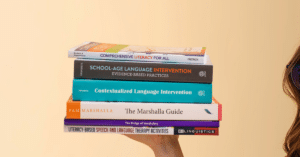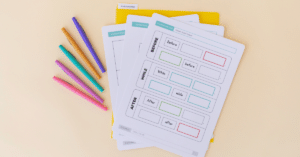Listen on Apple Podcasts Listen on Spotify
Want to hear more about this topic? Click here for all things scaffolding!
This Week’s Episode: Scaffolding – Setting the Stage
I’m going to show you exactly how to leverage your greatest therapy tool (you!)– no fancy materials required– in a way that empowers your students’ independence, contextualizing their learning, and makes planning. so. so. much. easier for you!
It is all in the scaffolding! Let’s drive in, shall we?
Links discussed
– Gillam, Gillam, and Reece (2012) provided small-group intervention three times a week over 6 weeks. The intent of the research study was to evaluate narrative intervention that is contextualized (literacy based) versus decontextualized commercially available games and drill cards designed to increase vocabulary, sentence complexity, and social language. The contextualized intervention used explicit and implicit questions, vocabulary, and syntax thematically tied to literature. The results indicated that students’ comprehension and story retelling/generation skills improved more with the contextualized intervention as compared to decontextualized intervention.
– Click here for last week’s podcasts on Literacy-Based Therapy Bootcamp
– Free Caseload at a Glance sheet
Subscribe & Review in iTunes
Are you subscribed to the podcast? If you’re not, subscribe today to get the latest episodes sent directly to you! Click here to make your listening experience auto-magic and as easy as possible.
Bonus points if you leave us a review over on iTunes → Those reviews help other SLPs find the podcast, and I love reading your feedback! Just click here to review, select “Ratings and Reviews,” “Write a Review,” and let me know what your favorite part of the podcast is.
Thanks so much!
Transcript
When I was in grad school, the main type of therapy that I saw was drill-based. And I that's what I learned. That's how I was taught to do therapy. So when I started in the schools, that's what I did. I just used that drill-based approach that I got really good at. But I realized that my students were struggling with generalization. I went to several IEP meetings, where I was very, very excited to report this amazing progress that students made towards their goals. But before I had a chance to share, the teacher would always inevitably give her update or his update, and what I was seeing in the therapy room, wasn't matching what was happening in the classroom. Too many times. So I dug into the research to figure out a better way to structure my therapy and help my students work towards generalization.
And so I ended up landing on literacy-based therapy. I will do a very, very quick overview. But last month on the podcast, we talked all about literacy-based therapy with tons of different ideas and resources to navigate that. So definitely reference that if you want more information. And just something that was interesting that I noticed, so when I was doing that drill-based therapy, we get to pick tasks that are at the student's level.
Articulation is a really great example. So we figure out how a student is doing, and they're either in isolation, in syllables, in words, in phrases, sentences, and we can just, we can simply adjust the task. And if the student's struggling at the phrase, then we'll jump back to the word level. And so it's easy to jump back and forth there. However, when we're working in context, which is what I found, there's a lot of research to support working in context, but it's a little bit messier. There aren't as many structured tasks. And there is still some of that involved, but that's why scaffolding is so incredibly important, because we can work in context if we have appropriate strategies and scaffolds in place to set our students up for success.
So I'm really excited to dive in on all of the different scaffolds that we can use, have a good refresher, and then just to empower all of us to work in a purposeful context, in a meaningful context, throughout our therapy. And then the ultimate goal is to get students to be using these skills in the classroom, and it's just one strategy that we can use to work towards that.
And then I just wanted to share a little bit of the research behind this contextualized approach, because I know I was very skeptical when I first started. So I didn't think there was any way that I would get enough meaningful repetitions of these students' skills in context. I was worried about just being a tutor and not really teaching students meaningful skills, and also just not getting the volume that I needed. That Gillum and Reese in 2012 put together, it was a small group intervention, and they evaluated a literacy-based approach versus a decontextualized, more drill-based approach. And they found that student's comprehension in story retell/story generation skills improve more with a contextualized approach. So even if we're getting less repetitions, we're not getting a bajillion K, like initial K words, or whatever it may be. But we're targeting the skills in a really meaningful context that students can really hook onto and really make some meaningful progress towards these very functional skills that they need to participate in the classroom. So, yeah, that's what we've got there.
And that doesn't mean that, and we'll talk a little bit more about it, but there definitely is still a time and a place for that drill-based practice. There is still a time and a place for teaching skills. That's always very, very important. We will... So we'll talk a little bit about what that looks like in context. But I think this study was really helpful in getting me to wrap my head around the potential impact that trying this new approach can have.
And there are also some other nice benefits. It happens to make it very easy. So literacy-based therapy, you get to pick a book and work on a theme around that. It makes it really easy to plan. It's very, it ends up providing a predictable structure for students, and it also provides a predictable structure for us. We get really good at using a particular book or article, and we can really dive into it and provide some really amazing intervention. And that also yields a very meaningful context, which we've talked a lot about. And then it's nice because with the framework, we can start with simpler skills and then really shape them to build onto a larger goals. So we might be working on some grammatical structures, or some sentence structures, or very specific skills, but then we can shape that into using those, using that grammar, using those sentences, when retelling a story, for example. So we get to take those skills and put them into a meaningful context in a way that students would actually be using it.
So we've got some evidence to show us that this yields some nice outcomes for our students, and it's definitely not, there's still more research to be done, and we still want to use our clinical judgment. But just from personal experience, I've had a lot of success, and I've been really impressed with the research. But then again, you're the clinician, and you get to implement this in the way that you see fit. But just to recap, we've seen some studies that documented improved outcomes in expressive and receptive vocabulary narratives by using this more contextualized approach.
And Dr. Ukrainetz gives a nice five step framework that we can use to navigate this in our therapy sessions. So we'll just do a super quick overview, but like I said, check out last month's podcast episodes if you want to give a more thorough overview.
But the first step, there's pre-story knowledge activation. We help that student identify what they already know about the given topic or theme. We can ask questions. We can do a book walk. We can fill in a graphic organizer. We can do a virtual field trip. Whatever we need to fill in that student's background knowledge. The second step is shared reading where we simply read the book. The third step is post-story comprehension activities. And we'll talk about how to scaffold this, but we can just ask questions, just have them be verbal, have a discussion about the story. A lot of times our students need more support, so we can give them visual choices, or fields of choices, whatever makes the most sense.
And then for four, we have focused skill activities. This is where we spend the most time in the unit. And we specifically target the speech and language skills that we need to. And then for the fifth step, we create a parallel story. And this is, again, another opportunity for students to integrate all of the skills they targeted throughout the unit, and then we get to create a story that's similar to what we read throughout the unit.
Just a quick tip to start navigating all of this, because it can be overwhelming if I'm like throwing, "Okay. Use this therapy structure. Use these scaffolding strategies, and just go for it." How do you get set up? How do you get it organized? So that's where the Caseload at a Glance comes in. That is a very helpful way to break down your caseload. So what I like to do is I list... You can list your groups. You can list by grade. You can list by class, whatever makes the most sense for you.
In this example, we list the grades. So I could just go down and do preschool, kindergarten, first, second, third, fourth, fifth. So I would list the grades or, like I said, classroom, group, whatever you want to do. And then I go through all of my students' IEPs. So I would start, let's say Johnny is first. So Johnny is working on K, so I would put a K in the articulation box and just put one tally. And then he's also working on inaudible nouns, so I put that under grammar, add a tally. Let's say Shanique was working on K and WH questions. So I add a tally next to K, because that's what Johnny was working on too. And then she's also working on WH questions, I write WH questions, and add a tally. And then I go through all of my student's IEPs and just have a short hand of the goals. That's how I like to do it. You can adjust this however you want, and whatever will work for your brain. But for me, I really like having a shorthand of the goal.
I, typically, only do this once a year, just to get familiar with my caseload at the beginning of the year, or if I'm feeling super overwhelmed. But then I just map it out, and then when I'm done, I can see exactly which goals my students are working on. And I just make a couple copies of the Caseload at a Glance, and then I've worked through to figure out, "Okay, I need to make sure I have assessments for all of these goals." And then I go through and make sure I have them all accounted for. Then I need to make sure that I have visuals to teach all of these skills, and I go through, and then I just start highlighting them as I put together the visuals and the assessments. And that's just a really nice way. Because we won't tackle it all at once, and it's just a nice way to make progress.
So if I were starting out with a brand new caseload, I would set a goal. Whatever's realistic. Am I going to prep one visual a day? Am I just going to try and do a batch of 10 every week? Whatever it may be. But it's just a way to organize everything that we're working on and just get it out of our heads onto paper, so we can easily see what's going on.
And then you can also use it, like I said, for assessments for visuals, I really like using this for professional development too. So then if I'm deciding which conferences I want to attend, or which online courses, if I have 15 students with grammar goals, and I feel like I need some help with grammar, then I'm going to seek out some courses that will help me with that. Or if I really want to work on social language, and I know that's something that really frustrates me or that I feel like I'm not doing a great job on. So that's how I can prioritize that, and it's just a really nice way to keep track and see yourself.
So like we said, the Caseload at a Glance is a nice way to build your core materials. Really, all that you need are your assessments, your visuals, or whatever you're using to teach, and then you. You are your best therapy tool, which is why I mentioned that professional development. So if you have the evidence-based strategies that you can use, I mean, it's nice to have stuff, but if you have that, you could just run even without the assessments and the visuals. And I do think that having those organized and laid out makes our jobs a lot easier, but the you is the most important element of this whole equation. I think that's where we would want to focus our efforts, and that's where we'll get the most bang for our buck. So those are all of our core materials.
And then the next thing that we need to do is to have some kind of context for our therapy. We want to be curriculum-based, and we want to be educationally relevant. The five step framework that I talked about works really well as a context for all of these different skills. So we move through that five step framework, and we simply select a text that works well, that aligns with what they're talking about in the classroom. So a lot of times, speech therapists feel it's a challenge to get passages from the classroom. I see a lot of SLPs using theme-based units. So just something that is a little more generic, something that, especially in the younger grades, we know they're talking about in the classroom. So just the different seasonal topics.
But usually, we can also get at least a little, even just asking our students, and asking what they're learning about in social studies, for example, or in science. And we can pick or select articles like readworks.org is an amazing resource. Newsela is an amazing resource with some great passages and texts that we can use to target students, like the skills.
Sign up to receive email updates
Enter your name and email address below and I'll send you periodic updates about the podcast.




Reader Interactions